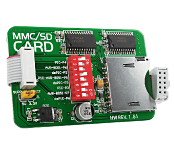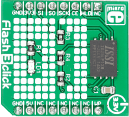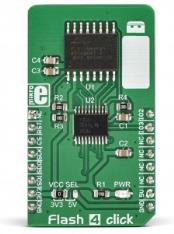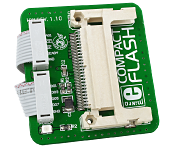|
|
| |
|
 | Search: |
|
|
 |

|
|
Secure Digital Card or SD Card is a very popular storage media, which offers huge amounts of storage area. SD Cards are on the market for quite some time. They are constantly evolving and improving, offering higher memory capacities, faster data rates, shorter access times, etc. The SD Card standard was first introduced in August 1999 by joint efforts between SanDisk, Panasonic (Matsushita Electric), and Toshiba, as an improvement over existing MultiMediaCards (MMC) standard. Since then, several revisions have been made. The microSD Card is the smallest SD Card version with the only 5mm in length and 11mm in width.
|
|
|
|
|
 |

|
|
The MMC/SD Board is an effective and low-cost board used to connect a development system to MMC or SD cards. This board uses SPI communication for data write or read to/from MMC/SD card. It comes with many ready-to-use examples. |
|
|
|
 |

|
|
The Flash Click board is an accessory board in mikroBUS form factor. It's a compact and easy solution for adding flash memory to your device. It features M25P80 8Mbit serial Flash memory module with advanced hardware write protection mechanisms. It supports high-performance commands with a clock frequencies of up to 75MHz. Memory is divided into 16 sectors, each containing 256 pages. Flash Click communicates with the target board via an SPI interface. The board is designed to use a 3.3V power supply only. It has a green LED which indicates when the board is powered. |
|
|
|
 |

|
|
Flash 2 click is a mikroBUS add-on board for adding more Flash Memory to your target board microcontroller. It carries Microchip's SST26VF064B flash-memory module with 64 Mbits capacity. It's a highly reliable module with a specified minimum of 100,000 read and write cycles and with over 100 years of Data Retention. For data security, the module features a One-Time Programmable (OTP) 2 KB bit secure ID and a 64 bit unique, factory pre-programmed identifier. Additional software security measures include inidividual-block write Protection with permanent lock-down capability. Flash 2 click communicates with the target MCU through the mikroBUS SPI interface (CS#, SCK, MISO, MOSI) with additional functionality provided by the #HOLD pin (in place of default mikroBUS™ RST pin). The board is designed to use a 3.3V power supply. |
|
|
|
 |

|
|
Flash 3 click is a mikroBUS add-on board for adding more Flash Memory to your target board microcontroller. It carries an ISSI IS25LP128 IC with 128 Mbit capacity.
The high-performance Flash chip operates at 50MHz at Normal and 133MHz at Fast Read speeds.
It is specified to standard 100,000 erase/program cycles with more than 20 years of data retention. The data can be erased in sectors or blocks and programmed with 1 to 256 bytes per page.
Each chip has a 128-bit unique ID for each device.
Flash 3 communicates with the target board through the mikroBUS SPI interface with additional functionality provided by HOLD, CE and WP pins. It is designed to use a 3.3V power supply only. |
|
|
|
 |

|
|
Flash 4 click is a perfect solution for the mass storage option in various embedded applications. With fast performance being one of its key features, Flash 4 click can also be used for the code shadowing, execute-in-place (XIP), and data storage. It features the S25FL512S Flash memory module made by combined high-performance MirrorBit® technology and Eclipse™ architecture. The 512 Mbit SPI Flash memory module is one of the fastest and most reliable Flash modules on the market.
It comes in the package which also includes the mikroSDK™ software and a library with all the functions. The Click board™ comes as a fully tested and approved prototype, making it a reliable device ready to use on the development board. |
|
|
|
 |

|
|
The Compact Flash Board allows you to connect your development or prototype board to the Compact Flash card. You just have to establish connection between these two devices in order to enable data write or read to/from the Compact Flash card. |
|
|
|
 |
|
|

